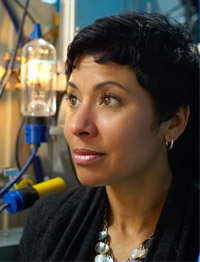 Technology Review – ME Professor Ann Marie Sastry wants to rid electric vehicles’ battery systems of most of the stuff that doesn’t store energy, such as cooling devices and supporting materials within the battery cells. It all adds up to more than half the bulk of typical lithium-ion-based systems, making them cumbersome and expensive. So in 2007, she founded a startup called Sakti3 to develop solid-state batteries that don’t require most of this added bulk. They save even more space by using materials that store more energy. The result could be battery systems half to a third the size of conventional ones.
Technology Review – ME Professor Ann Marie Sastry wants to rid electric vehicles’ battery systems of most of the stuff that doesn’t store energy, such as cooling devices and supporting materials within the battery cells. It all adds up to more than half the bulk of typical lithium-ion-based systems, making them cumbersome and expensive. So in 2007, she founded a startup called Sakti3 to develop solid-state batteries that don’t require most of this added bulk. They save even more space by using materials that store more energy. The result could be battery systems half to a third the size of conventional ones.
Cutting the size of a battery system in half could cut its cost by as much as half, too. Since the battery system is the most expensive part of an electric car (often costing as much as $10,000), that would make electric cars far cheaper. Alternatively, manufacturers could keep the price constant and double the 100-mile range typical of electric cars.
The limitations of the lithium-ion batteries used in electric cars are well known. “Most liquid electrolytes are flammable. The cathode dissolves,” says Sastry. Keeping the electrolyte from bursting into flames requires safety systems. And to extend the electrode’s lifetime and prevent heat buildup, the battery must be cooled and prevented from ever fully charging or discharging, resulting in wasted capacity. All this adds bulk and cost. So Sastry wondered if she could make a battery that simply didn’t need this much management.
Sastry’s solid-state batteries are still based on lithium-ion technology, but they replace the liquid electrolyte with a thin layer of material that’s not flammable. Solid-state batteries are also resilient: some prototypes demonstrated by other groups can survive thousands of charge-discharge cycles. And they can withstand high temperatures, which will make it possible to use materials that can double or triple a battery’s energy density (the amount of energy stored in a given volume) but that are too dangerous or unreliable for use in a conventional lithium-ion battery.
To make solid-state batteries that are practical and inexpensive to produce, Sastry has written simulation software to identify combinations of materials and structures that will yield compact, reliable high-energy devices. She can simulate these materials and components precisely enough to accurately predict how they will behave when assembled together in a battery cell. She is also developing manufacturing techniques that lend themselves to mass production. “If your overall objective is to change the way people drive, your criteria can no longer only be the best energy density ever achieved or the greatest number of cycles,” she says. “The ultimate criterion is affordability, in a product that has the necessary performance.”
Although it may be several years before the batteries come to market, GM and other major automakers, such as Toyota, have already identified solid-state batteries as a potentially key component of future electric vehicles. There’s a limit to how much better conventional batteries can get, says Jon Lauckner, president of GM Ventures, which pumped over $3 million into Sakti3 last year. If electric vehicles are ever to make up more than a small fraction of cars on the road, “something fundamental has to change,” he says. He believes that Sakti3 is “working well beyond the limits of conventional electrochemical cells.”
Sastry is aware that success isn’t guaranteed. Her field is something of a technological battleground, with many different approaches competing to power a new generation of cars. “None of this is obvious,” she says.
The above story is reprinted (with editorial adaptations by the U-M Mechanical Engineering Department) from materials provided by Technology Review. Read the original story at Technology Review.